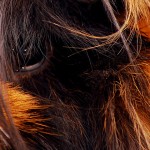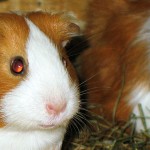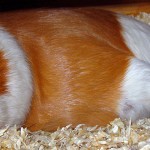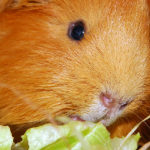Keeping Guinea Pigs inside is the most common way. For the last few years there is a definite trend out there away from wired cages with plastic tumb to bigger and more pretty looking cages whom fit perfectly to the furniture. This will make your cavies happy too! There are some very good builders of cages out there. But unfortunately the well known hamster cage is still sold too often as a Guinea Pig cage. Do not trust your dealer: None of this cages you can buy in pet shops are sufficient to cavies! Less space may encounter many diseases and a bigger and more expensive cage is worth the price. Do the best for your pets and choose a big one and arrange it like the cavies would do. This means: Big – with much space to run and also many places to hide.
How big has a Guinea Pig cage to be?
There is a rule of thumb: Every cavy you keep should have at least 0,5qm / 5 sq ft space. More space is quite welcome. If you have a group with more than one male cavy you’ll need 1qm / 10sq ft for each pet. This is highly essential because they need room where they can dodge to tolerate each other much better. If you create a cage on your own you can easily spend more space to your group. With a bigger cage you prevent parasites very effective. Prefer an elongated cage because your cavies would do too.
Are cages form pet shops suitable for Guinea Pigs?
You’ll often get phrases like “This cage fits the needs perfectly” or “It is special designed for cavies” if you want to buy a cage in pet shops. For small cages you’ll hear somthing like “It is for one Guinea Pig only“. But it is not. It isn’t designed for Guinea Pigs at all. Small cages are designed for other much smaller rodents like hamsters who are loners furthermore. Guinea Pigs are group animals and need room. The biggest common cage available with top wire is about 1,20m x 0,60m / 4ft x 2ft. But this is a area of only 0,72m² / 7 sq ft and this is much too small for two Guinea Pigs. And the biggest seen wire cage available with dimensions of 1,40m / 0,70m may two scratches along. Keep in mind: Building cage towers isn’t a solution as well. Prefer elongated cages because Guinea Pigs are worse climbers and separate flats will not catch the problem. Your cavies need space at one level for running and bouncing.
Guinea Pig cages need to breath
In pet shops you can buy cages with wired tops and with plastic caps. Cages with plastic cap are harmful because they block circulation of air which is much important. Cavies are big rodents and produce a lot of urine. This urine contains ammonia gas and this may cause serious problems with their small organism if it retain. Also a plastic cap can make your cavies home to a green house – especially in high tempered areas or during the summer months. So prevent trapped heat and make sure the cage can breath and the air can always circulate.
Wires of cages for rodents should never be painted. Guinea Pigs might nibble on the wire and can swallow the varnish.
If you have already bought a wired cage for your cavies and it seems to be too small you can add a wooden board as a new layer. This reduces the problem – but a bigger cage is always the better solution.
Do It Yourself Guinea Pig cage
The much better way is always to build a Guinea Pig cage by your own or to let it build individually by a professional. The benefit is that you can build exactly to your needs and not at least to the needs of your cavies and you can use any space you’ve got optimal. DIY demands skill of course and a good well filled toolbox.
The following two images shows our DIY cage build up 2005 for 5 Guinea Pigs. It is build with laminated / glued wood and fixed by some wood screws only. The soil has massive stainless steel trays. Others use pond liner / foil to prevent soaking. This is a cheap and good solution too! The cage is not that big but thats not a problem. As you can see on the images, our Guinea Pigs have much more space to use and they use is regularly to run and bounce around.
- Our DIY Guinea Pigs’ cage
- Our cavies leaving the cage looking forward for food
After the last years better cages for Guinea Pigs become more popular and there are some manufacturers out there who will help you to build up or buy a perfect fitting cage for you and your Guinea Pigs.
Finding the best location for the cage
You can decide to place the Giunea Pigs cage either on the base or elevated. Both positions has pros and cons. For your pigs: If its cage is elevated humans might not be that big and alarming. This is a good choiche for frightened and/or new cavies and many people told us that this kind of position helps to get the cavies tame more quickly. On the other side a elevated cage is not suitable to let them go out like shown on the images above so your cage has to be much bigger. To take them out daily manually is not a good option!
A cage on the floor is the opposite. You’re appearance is much taller to your pigs and this can frighten them longer. Our experience is, that this is not that problem. Be careful and go down on your knees is you have something to do around them. As time goes by you will not be a problem for them. The much bigger reason for a placement at base is that your cavies can easily use more space if you open the gate (secure the room before). He haven’t got any gate so our cavies can decide themselfes when they wan’t to go out.
Interior fittings of a Guinea Pig cage
There a some must haves which belongs to all cages:
- At least one hut for each cavy
Huts should be made of wood and should not be painted. Huts always should never have any base (they will urinate it soon) and always opened doors. There are huts out there with too small windows. These huts are not made for Guinea Pigs. Take a hut which windows are large enough that no Cavy – even the biggest – may caught in it. - Wodden hideouts,
Objects like this are not only objects for decoration – they are essential for every Guinea Pig cage and simulate the natrual habitate. Your pigs will use it to hide, jump on or nibble on it. Take care that you only buy natural products without any paintings, glue or something like that. - Bowl for food / water
Guinea Pig bowls should be heavy and made of fired, glazed clay to prevent that it can be tipped over. Use it to put food and water in it. - Water bottles
To provide water we recommend bottles like the traditional no drip water bottles. Providing water in bowls is more natural for sure but the water gets soiled very soon. We’ve tested it many times but our Guinea Pigs do not wan’t to drink water from a bowl wo we completly swiched to water bottles.
Additional furnishings
- small hammocks
- Tubes of clay
- Big Stones (good for their claws)
- Tree branches
- Tipis and tents
- empty loo-rolls or socks filled with hay
Which litter / bedding for Guinea Pigs cages is the best?
There are serveral types of litter aviable and it is to your needs in which bedding you should prefer. Over the years we nearly tried every litter we’re got. The bigger your cage is, the more you take attention to its properties:
- Dust-free
Litter should be as much dust free as possible. This is important for you, you’re rooms and you cavies too. Dust-free litter prevents sneezing and can prevent from some allergy. - Absorbency
The more your litter can absorbe urine the less you need to clean up the cage. Urine is always a bigger “problem” than feces. - Price
To say it clear: If you want to keep Guinea Pigs as much species-appropriate as possible, you have to forget about litter you can by in a drugstore or department store. This is way to expensive and the packages way to small because you really need much litter. But also buying large packages from pet stores or at the internet becomes a cost factor even though those big packages are much cheeper.
As said before, we tried many types of litter with many different kind of materials. Our best experience we made is the default sawdust litter you can buy everywhere. It is not that expensive and absorbes urine comparatively good. We’ve also made good experiences with litter made of hemp. Beech wood granulate or litter made of corn was not that good.
Do not use newspaper or cat litter. Both is toxic for Guinea Pigs.Comparison of litter / bedding for Guinea Pigs
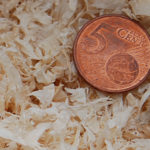 |
Wood chips (like Kaytee Aspen Bedding) ~ medium in absorbency + low price – produce much waste |
 |
Linen straw (like Euro Lin) + high absorbence + low waste + nearly dust free – sticks on fresh fodder |
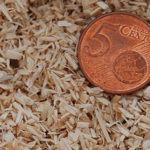 |
Softwood bedding (like So Phresh Natural Softwood) + high absorbency + low waste + nearly dust-free |
How to and how often you have to clean up the cage
- Wet zones should be removed immediately you’ve spot one.
- Applied to its size the complete cage should be cleaned up once or two times a week.
- Once a month you should clean the cage using a dust cleaner to prevent parasites. Do not use any kind of disinfectant / antiseptic. There are more harmful than useful. If you really need to disinfect use vinegar essence.
We clean up our cage shown above once a week and wet zones always if we see them. A total cleanup takes about 30 minutes but our cage is quite difficult to clean because of its layers and corners. A default cage can be cleaned up in less than 10 minutes completely.





